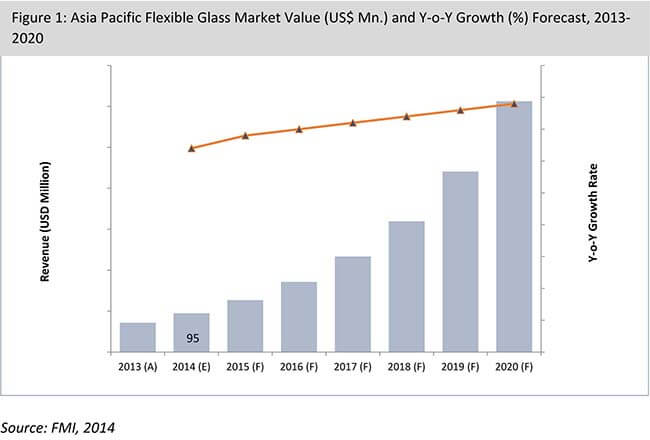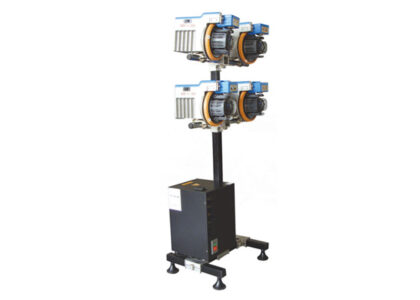
The Asia Pacific flexible glass market is set for remarkable growth in the coming years, driven by its wide range of applications in high-tech industries and rapid technological advancements. With an initial market value of USD 612.7 million in 2020, the market is projected to experience an impressive compound annual growth rate (CAGR) of 36.5%, underscoring the potential for further market expansion across the region. This growth trajectory is driven by increased demand for flexible, lightweight, and durable materials across several sectors, including consumer electronics, automotive, and energy industries.
Understanding the Asia Pacific Flexible Glass Market
Flexible glass is a revolutionary material that combines the strength and durability of conventional glass with the versatility of plastic-like flexibility. It is ultra-thin, highly flexible, and lightweight, making it a preferred material in industries where traditional rigid glass falls short. Its ability to withstand bending and twisting without breaking or cracking makes it especially suitable for applications in flexible displays, advanced touchscreens, curved solar panels, and wearable devices.
In the Asia Pacific region, the flexible glass market has gained traction due to the growing emphasis on innovation and cutting-edge technology, particularly in countries such as China, Japan, South Korea, and India. These countries are not only major electronics manufacturing hubs but also house a significant portion of the world’s largest consumer bases, contributing to the increased adoption of flexible glass solutions.
Asia Pacific Flexible Glass Market Value and Growth Projections
As of 2020, the Asia Pacific flexible glass market was valued at USD 612.7 million, and its growth projections are nothing short of remarkable. With a projected CAGR of 36.5%, the market is expected to continue on an upward trajectory throughout the forecast period, largely due to expanding consumer electronics and automotive industries in the region.
The development of advanced smartphones, foldable displays, wearable technology, and flexible photovoltaic cells are key sectors driving the demand for flexible glass. In addition, the rise of smart cities and the proliferation of IoT (Internet of Things) devices are likely to increase the need for durable, thin, and bendable materials. With China and South Korea at the forefront of innovation in flexible display technology, these countries are expected to contribute significantly to market growth.
The renewable energy sector is also playing a crucial role in boosting demand for flexible glass. As governments in the region prioritize clean energy, flexible glass is increasingly being used in lightweight, bendable solar panels, which are easier to install on unconventional surfaces, such as rooftops, and offer more flexibility in deployment.
Prominent Drivers of the Asia Pacific Flexible Glass Market
The Asia Pacific flexible glass market is being driven by several key factors:
- Rising Demand in Consumer Electronics: Flexible glass is playing a pivotal role in transforming consumer electronics, with manufacturers continuously seeking ultra-thin and bendable materials to innovate new product designs. Smartphones, foldable displays, and wearable devices are some of the prominent applications where flexible glass is making a significant impact. The increasing popularity of foldable smartphones, in particular, is fueling demand for flexible glass as it provides both aesthetic and functional benefits over rigid alternatives.
- Automotive Industry Expansion: The automotive sector in the Asia Pacific is witnessing substantial growth, and flexible glass is finding new applications in the development of advanced automotive displays and curved dashboards. As the industry moves towards more connected and automated vehicles, the demand for sophisticated in-car displays and lightweight components is likely to contribute to the market’s growth.
- Renewable Energy Sector Growth: Governments across Asia Pacific are heavily investing in renewable energy sources such as solar power. Flexible glass is increasingly being utilized in solar panels due to its lightweight and bendable properties, which make it easier to install on non-flat surfaces. The region’s focus on sustainability and energy efficiency is further promoting the use of flexible glass in these applications.
- Technological Advancements and Innovation: Continued innovation in material science and manufacturing processes is reducing the cost of production and improving the overall performance of flexible glass. With advancements in display technology and the increased adoption of flexible OLED displays, manufacturers are seeking flexible glass as a key material to enhance product performance and durability.
Challenges Faced by the Asia Pacific Flexible Glass Market
Despite its rapid growth, the Asia Pacific flexible glass market is not without challenges:
- High Production Costs: One of the main barriers to widespread adoption of flexible glass is the high cost of production, which remains significantly higher compared to traditional glass or plastics. As the market matures, manufacturers are expected to face increased pressure to reduce production costs while maintaining quality standards.
- Limited Manufacturing Capacity: While there is significant demand for flexible glass, the production capacity in the Asia Pacific region is still in the developmental stage. Manufacturers need to invest heavily in scaling up production capabilities to meet the growing demand from various industries.
- Technical Challenges in Integration: Despite its advantages, integrating flexible glass into existing manufacturing processes can present technical challenges. Some industries, particularly in consumer electronics, may encounter issues related to the durability and performance of flexible glass when used in extreme conditions.
- Competition from Alternative Materials: The flexible glass market faces stiff competition from alternative flexible materials, such as plastic polymers, which offer similar flexibility at a lower cost. These alternatives could potentially slow down the adoption of flexible glass in certain sectors.
About Future Market Insights (FMI)
Future Market Insights, Inc. (ESOMAR certified, recipient of the Stevie Award, and a member of the Greater New York Chamber of Commerce) offers profound insights into the driving factors that are boosting demand in the market. FMI stands as the leading global provider of market intelligence, advisory services, consulting, and events for the Packaging, Food and Beverage, Consumer Technology, Healthcare, Industrial, and Chemicals markets. With a vast team of over 400 analysts worldwide, FMI provides global, regional, and local expertise on diverse domains and industry trends across more than 110 countries.
Join us as we commemorate 10 years of delivering trusted market insights. Reflecting on a decade of achievements, we continue to lead with integrity, innovation, and expertise.
Contact Us:
Future Market Insights Inc.
Christiana Corporate, 200 Continental Drive,
Suite 401, Newark, Delaware – 19713, USA
T: +1-347-918-3531
For Sales Enquiries: sales@futuremarketinsights.com
Website: https://www.futuremarketinsights.com
LinkedIn| Twitter| Blogs | YouTube





